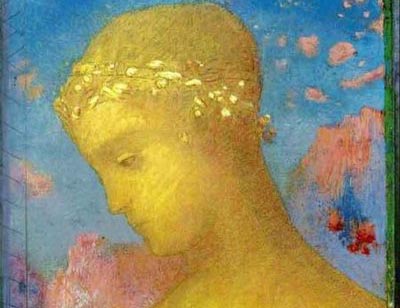翻译:象征主义宣言
SYMBOLIST MANIFESTO (JEAN MORÉAS)
象征主义宣言(让-莫雷亚兹)
翻译:胡勉之 杨欣冉
As with all arts, literature evolves: a cyclical evolution with strictly determined returns and which become more complicated of various modifications brought by the step of time and the confusion of circles. It would be superfluous to point out that every new progressive stage of art corresponds exactly to senile degeneration, at the ineluctable end of the immediately previous school. Two examples will be enough: Ronsard triumphs over the impotence of the last impressionists of Marot, Romanticism unfurls its royal flag on the classical debris badly kept by Casimir Delavigne and Steven de Jouy. It is because any demonstration of art succeeds inevitably in becoming impoverished, in exhausting itself; then, of copy in copy, simulation in simulation, what was full of sap and freshness becomes dried out and shriveled; what was the new and the unprompted becomes banal and commonplace.
和其他所有形式的艺术一样,文学也包含如下要素:周而复始的革命,伴随着不可改变的成果。这一切随时间的推移、随着乱局的周而复始而变得越来越复杂。尽管显得有些多余,我还是要说,一切艺术的新纪元,必然标志着上一代审美的衰亡,标志着旧派艺术不可避免的终结。我在这里举两个例子:诗人龙萨一扫马罗讽刺诗的沉疴;而不管德拉维涅和史蒂文·德·茹伊再如何抱残守缺,浪漫主义的大旗终会在古典的废墟上迎风招展。这是因为一切成功的艺术表达都是依靠着自我消耗实现的,消耗到最后就一定会变得贫瘠;随着临摹和戏仿,艺术的琼浆玉液必定干涸、枯萎,曾经充满活力的崭新艺术最终会归于腐朽,归于庸才。
So Romanticism, having sounded all the tumultuous warning bells of uprising, had its days of glory and battle, lost of its force and its favour, abdicated its heroic boldness, became ordered and classified, sceptical and full of common sense; in the honorable and mean-minded attempts of the Parnassians, Romanticism hoped for a false resurgence, only finally, such a monarch had to fall into senile decay, and in the end was only able to be dethroned for the naturalism in which one could grant seriously a value of protest only, legitimate but poorly advised, against the insipidity of some novelists then grant seriously a value of protest in fashion.
历史上,享尽了战斗的光荣之后,一阵警钟在浪漫主义的头顶上敲响——它从此失去了力量和意趣,从此放弃了它英雄般的勇气,变得循规蹈矩、充满顾虑和成见。巴那斯派的诗人怀着卑鄙的意图做出了一次伟大的尝试。他们的浪漫主义希望一次虚假的复兴,因为它的文化专权即将走向没落和衰残,即将被自然主义打个粉碎。而自然主义呢,也只会摆出一本正经的样子,批评流行小说家的乏味——这固然合情合理,却毫无意义。
One waited for a new manifestation of art therefore, necessary, unavoidable. This manifestation, brooded for a long time, has just hatched. And every insignificant practical joke of the cheery-eyed press, all the anxieties of the serious critics, every bad mood of the surprised public in its sheepish carelessness, are only bringing about this actual evolution in french letters more and more every day, this evolution which impatient judges have noted to be, by an incredible antinomy, decadent. However, decadent literature is principally tough, stringy, timorous and servile: all the tragedies of Voltaire, for instance, are marked with these signs of decadence. And for what of these reproaches can be claimed as regards the new school? The abuse of pomp, strangeness of metaphor, a new vocabulary or harmony go together with colours and lines: characteristics of any revival.
因此,我们期待着新兴艺术的宣言——这是必须的,也是必然的。这一部宣言已经酝酿了很久,今天我把它发表出来。欢乐的报纸上每一则无关紧要的玩笑嬉戏、严肃批评家们的每一次焦急、大惊小怪的群众每一次鲁莽失态、大发脾气,都让法语的文字日新月异。尽管如此,那些苛刻的评论家还是把这种大众的运动归为一场“颓废派革命”——一种庞大的矛盾体。当然,不管他们怎么说,真正的颓废文学从根本上讲还是艰难、严谨、胆怯而卑微的——伏尔泰的悲剧就充斥着这些元素。换言之,之所以颓废派能称为一种全新的流派,正因为它们滥用浮夸的手法,疏远比喻的技巧,因为他们使用新的词汇,和谐地运用色彩和线条——总之,文学复兴运动的一切要素都在其中。
We have already offered the name of symbolism as the only one able of indicating reasonably the actual tendencies of the creative mind in art. This name can be supported.
今天,我们把象征主义冠为唯一能代表新兴艺术潮流、代表创新艺术思想的流派。对于这一点,我们有充分的理由。
It was said at the beginning of this article that the developments of art offer cyclical extremely complicated differences: for example, to track the exact parentage of the new school we should go back to certain poems of Alfred de Vigny, and on up to Shakespeare, even mystical, even further. These issues would require a volume of reviews, saying that Charles Baudelaire therefore must be considered the true forerunner of the current movement, Mr. Stéphane Mallarmé subdivides the sense of mystery and the ineffable Mr. Paul Verlaine broke his honor in the cruel hindrances to poetry (that ) the prestigious fingers of Mr Theodore de Banville had softened up before him.
But the Supreme enchantment is not yet consummated: a persistent and jealous labor invites newcomers.
本文开头曾说过,艺术的发展是周期性的,前后的差异分析起来极其复杂。假如要追溯新学派的确切起源,我们应该追溯到阿尔弗雷德·德·维尼的某些诗歌,到莎士比亚,到神秘主义,甚至更远。讨论这个命题,需要很多文学评论的支撑。依照他们的评价,波德莱尔必须是最近象征主义运动的领导者,马拉美细分了象征主义的神秘感,连妙不可言的魏尔伦也被诗歌的残酷阻碍击碎了光环——在他之前,班维尔的伟大作品遇上这种阻碍也无能为力。尽管如此,诗歌至高的魔力还没有达成圆满: 它仍然欢迎着新的诗人,尽管这项工作充满着劳苦和嫉妒。
***
Enemy of education, declamation, wrong feelings, objective description, symbolist poetry tries to dress the Idea in a sensitive form which, however, would not be its sole purpose, but furthermore that, while serving to express the Idea in itself, would remain subjective.
The Idea, in its turn, should not be allowed to be seen deprived of the sumptuous lounge robes of exteranous analogies; because the essential character of symbolic art consists in never approaching the concentrated kernel of the Idea in itself. So, in this art, the pictures of nature, the actions of human beings, all concrete phenomena would not themselves know how to manifest themselves; these are presented as the sensitive appearance destined to represent their esoteric affinity with primordial Ideas.
象征主义诗歌与说教和宣告为敌,与错位的感知为敌,与客观描写的文字为敌,它以敏感的形式表达自己的观点,尽管这种形式并不是它的唯一目的。更进一步讲,这种形式虽然以它自己的方式来表达理念,但仍然是很主观的。
同样,象征主义的思想离不开类比,脱不下这一袭华丽的睡袍; 因为象征艺术的本质在于永远无法接近其理念之核心。所以在这种艺术中,自然的图画、人类的行为......一切具体的现象都不知道如何表现自己,都要呈现出敏感的表象,而这重表象注定反映了与其原始观念的深奥的亲缘关系。
The accusation of obscurity that has been made as regards such aesthetics by readers with broken staffs is not surprising. But what do we make of this? The Pythian Odes of Pindar, Hamlet of Shakespeare, the Vita Nuova of Dante, the Second Faust of Goethe, the Temptation of Saint-Antoine of Flaubert were not they also taxed by ambiguity?
这样一种模糊的概念,被那些抱残守缺的读者们批评「价值含糊不清」并不奇怪。我们应当怎么理解这些批评呢? 想想品达的《皮斯提亚颂歌》,莎士比亚的《哈姆雷特》,但丁的《新生》,想想歌德的《浮士德二世》,福楼拜的《圣安东尼的诱惑》,它们不都曾被批评“含糊不清”么?
For the precise translation of its synthesis, it is necessary for symbolism to take on an archetypal and complex style; of unpolluted terms, periods which brace themselves alternating with periods of undulating lapses, significant pleonasms, mysterious ellipses, outstanding anacoluthia, any audacious and multiform surplus; finally the good language – instituted and updated–, good and luxuriant and energetic french language from before Vaugelas and Boileau-Despréaux, the language of François Rabelais and Philippe de Commines, Villon, Ruteboeuf and so many other free writers hurling their acute language in the same manner as the Toxotes of Thrace hurled their snaky arrows.
为了更好地理解这套庞杂的体系,象征主义必须具有一种古老而繁复的风格:它必须拥有那些未受污染的名词,拥有起伏与停顿、神秘的省略号、特立独行的破格文体,拥有那些大胆而形式丰富的冗余;它必须拥有真正美好的语言——美好的丰富的充满活力的,自诞生以来就不断更新的,法国的语言。这是沃格拉斯和布瓦罗之前的语言,是弗朗索瓦拉伯雷、菲利普·德·康米斯、维隆、鲁特伯夫和许多自由作家的语言——这些作家往往用词尖锐,像色雷斯的步弓手投掷的蛇箭。
Rhythm: the ancient metric enlivened; a chaos learnedly ordered; the rhyme illucescente and beaten as a buckler of gold and bronze, to rhymes of unintelligible fluidity; the alexandrine with numerous and mobile stopping; the job of first certain numbers– seven, nine, eleven, thirteen – bold in the various rhythmic combinations of which they are the price.
古老的诗韵复苏了;诗界笼罩在新的混沌之中;诗歌的韵脚既如金铜之盾般浑厚又如幽壑深渊般神秘,曲折蜿转似亚历山大河。7、9、11、13,这几个基本音节数字的职责,蕴藏在无尽的诗韵组合中——这恐怕就是他们的价值。
Jean Moréas (1886)- translated by C. Liszt
让-莫雷亚兹(1886)




